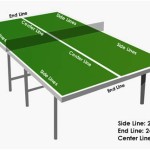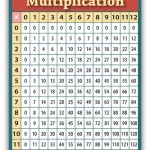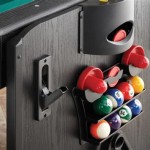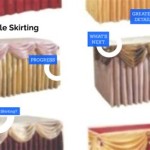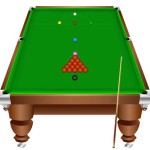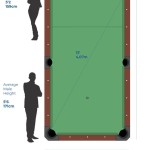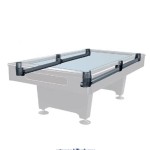How to Measure a Pool Table: A Comprehensive Guide
Accurately measuring a pool table is crucial for various reasons, ranging from purchasing the correct size of cloth and accessories to ensuring it fits comfortably within a designated space. Whether a potential buyer is considering acquiring a new or used table, or an owner is planning a room remodel, precise measurements are essential. This guide details the methodology for measuring a pool table, covering different aspects and providing valuable insights into achieving accurate results.
The primary measurement used to classify pool tables is the playfield dimension. This refers to the internal playing surface, bounded by the cushions (also referred to as rails) of the table. The external dimensions, including the table's frame, legs, and any decorative elements, are also important for space planning but are secondary to the playfield dimensions when determining the table's classification.
Pool tables are generally classified by their playfield size in feet. The most common sizes are 7-foot, 8-foot, and 9-foot tables. Understanding these classifications is fundamental to choosing the right table for available space and intended use. A smaller 7-foot table is suitable for tighter spaces, while a 9-foot table is often preferred for tournament play and by more experienced players who benefit from the larger playing area.
Key Point 1: Tools and Preparation
Before commencing the measurement process, gather the necessary tools and prepare the table. The essential tools include:
1.
Measuring Tape:
A sturdy measuring tape, preferably at least 12 feet in length, is necessary for accurately measuring the table's dimensions. A metal measuring tape is generally preferred over a cloth one due to its rigidity and reduced susceptibility to stretching, thereby ensuring more precise measurements.2.
Level:
A level, ideally a spirit level or a digital level, is needed to verify that the table is sitting level. This is not directly related to the measurement process but is crucial for ensuring accurate gameplay once the table is set up. Incorrect leveling can affect ball roll and trajectory.3.
Pencil and Paper:
A pencil and paper are required for recording the measurements obtained. It is beneficial to create a simple diagram of the table to note the different dimensions clearly. This helps in minimizing errors and provides a reference point for future use.4.
Helper (Optional):
While not strictly essential, having a second person can significantly assist in holding the measuring tape and ensuring it remains straight over longer distances, especially when measuring the length of the table.Prior to beginning the measurements, ensure that the pool table surface is clean and free of any obstructions, such as pool balls, chalk, or debris. These obstructions can impede accurate measurements. It is also advisable to have adequate lighting in the room to facilitate clear visibility during the measurement process.
Key Point 2: Measuring the Playfield
The most crucial measurement is that of the playfield – the surface on which the balls are struck. This measurement dictates the table's official size designation. The playfield is measured within the boundaries of the rubber cushions, also known as rails.
1.
Length Measurement:
The length is measured from the nose (where the cushion meets the slate) of the cushion on one end rail to the corresponding nose on the opposite end rail. Extend the measuring tape along the center of the playfield, ensuring the tape is taut and straight. The measurement should be taken at the point where the tape touches the cushion's nose. Note the measurement down on the paper.2.
Width Measurement:
Similarly, the width is measured from the nose of the cushion on one side rail to the corresponding nose on the opposite side rail. Ensure that the measuring tape is perpendicular to the length measurement. Again, take the measurement at the point where the tape meets the cushion's nose. Record the width measurement.3.
Verification:
It can be beneficial to take multiple measurements of both the length and width at different points along the rails to confirm consistency and accuracy. If there are slight variations, average the measurements to obtain the most representative dimensions.It is imperative to use the nose of the cushion as the measurement point, as this is the official standard. Measuring the actual exposed slate surface will yield incorrect results. The cushion nose represents the active playing surface boundary.
Key Point 3: Measuring External Dimensions and Height
While the playfield dimensions determine the table size, understanding the external dimensions is important for determining the overall space requirements in a room. It also ensures that the table's height aligns with standard ergonomic guidelines.
1.
External Length and Width:
To measure the external length, extend the measuring tape from the outermost point of one end of the table to the outermost point of the opposite end. Repeat the process for the external width, measuring from the outermost point of one side to the outermost point of the opposite side. These measurements will include the frame, any decorative trim, and the overhang of the rails. Record these dimensions separately from the playfield dimensions.2.
Height Measurement:
The height of the pool table is measured from the floor to the top of the playing surface (slate). This measurement is important for ensuring that players can comfortably reach and play on the table. Standard pool table height is typically between 29 1/4 inches and 31 inches. Use the level to ensure the measuring tape is perpendicular to the floor for an accurate height reading.3.
Leg Room and Clearance:
Assess the leg room beneath the table. Ensure there is sufficient space for players to comfortably stand and move around the table without obstruction. Also, consider the clearance around the table, allowing enough room for players to maneuver and take their shots effectively. Calculate the space occupied by a cue being used at various angles to ensure sufficient play area. The minimum recommended space around a pool table is generally 5 feet on all sides.Document all measurements carefully, distinguishing between playfield dimensions, external dimensions, and height. This detailed record provides a comprehensive understanding of the table's size and spatial needs.
In addition to the linear measurements, considering the weight of the pool table is crucial, especially when planning its installation and ensuring adequate floor support. Standard pool tables can weigh several hundred pounds, necessitating a reinforced floor in some cases. Consulting with a professional installer or structural engineer may be advisable for heavy tables or in situations where there are concerns about floor load capacity.
When purchasing or moving a pool table, it’s also important to note that the table often needs to be disassembled, either partially or completely, for transportation. Understand the disassembly and reassembly requirements, as well as any specialized tools or expertise needed. Hiring a professional pool table installer is highly recommended to ensure proper disassembly, transportation, and reassembly, preventing damage to the table and ensuring accurate leveling.
Furthermore, always compare the measured dimensions against the manufacturer's specifications, if available. This comparison can reveal any discrepancies or potential issues, such as warping or incorrect assembly. Inconsistencies should be addressed with the seller or installer to ensure the table meets the intended standards and playability expectations.
Finally, consider the type of pool being played. For example, carom billiards tables have different dimensions and may require specific measurement protocols. Ensure that the measurement process aligns with the requirements of the specific game being played on the table.

How To Measure Your Room For A Pool Table Royal Billiard Recreation

How To Measure A Pool Table Billiards Direct

How To Measure A Pool Table 4 Dimensions

How Do I Measure Space For A Pool Table Home Leisure Direct

What Is The Standard Size Of A Pool Table Measurement Guide Room

Measuring A Pool Table For Quality And Fair Play Sports Dimensia

Pool Table Size Chart Moving The Experts

Room Size Requirements Measurement Configuration

Pool Table Room Size Guide Chart Birkbeck Billiards

Pool Table Room Size Calculator


